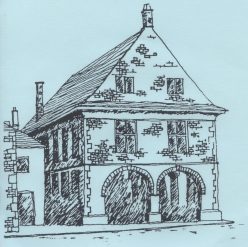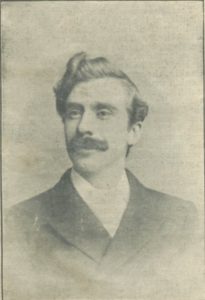Samuel James (Sammy) Ford (1869 – 1935)
“Surely one of the most remembered (Baptist) ministers at Minchinhampton must be Rev. S.J. Ford or “Sammy” Ford as people affectionately called him – though not to his face it must be understood!” So wrote Alan Edwards in 1977, when many of the older members of the Baptist Church still recalled a man of principle, a warm-hearted pastor who would give his last coin to someone in need.
Samuel grew up in Keynsham and Bristol, one of five boys; his father was a stonemason. On the 1891 Census he is described as a bookseller, but by 1897 he was being inducted as the minister for the chapel in Tetbury Street. He had trained at the Bristol Baptist College and this was his first appointment. Under his leadership the membership, largely consisting of mill hands and agricultural workers, grew and the church building was renovated, with new seating installed and the gallery re-fronted. It was about this time that carpenters, tilers and builders also joined the church; their skills were to prove invaluable in the years to come.
Like many of his calling, the Rev. Ford had a deep social concern and in 1906 he began the task of constructing a new institute and boarding house to provide “a good healthy place of resort free from the temptations of the public house”. The aim was to provide entertainment for Minchinhampton people, in the form of billiards, a library, reading room and a temperance bar, as well as a lodging for travellers complete with hot baths. The local newspaper described it as “a testimonial to Mr. Ford’s desire to benefit the working classes.” The site was that of the old caretakers’ cottage in Tetbury Street and Rev. Ford was one of the first to help with the demolition, along with 54 other volunteers giving their labour free. The building began under the guidance of Thomas Gardiner and the Pastor; the names of all involved, together with the hours worked, were carefully recorded – men and boys were involved in skilled work and women joined sewing groups. The Institute was opened on 6th June 1907 in time for Rev. Ford’s tenth anniversary, at a total cost of £1,125.6s.2d. and commemorated in a special booklet.
Rev. Ford was always prepared to stand by his beliefs, as was shown by an incident during his pastorate. It is probable that he withheld part of his rates, as a protest against the overtly Anglican teaching in state schools, which led to an appearance in court and commitment to Gloucester Prison. His values, however, found expression in anger when his grateful congregation paid the missing portion and he was released!
In 1910 he married Elsie Hodges and she continued to help in his ministry. There is little record of his life during the difficult years of the Great War, but the Pastor and Mrs. Ford’s Christmas card of 1918, a copy of which survives in the Local History Collection, shows a soldier in full uniform with the text “Quit you like Men and Be Strong”- perhaps a reference to the difficulties those returning to Minchinhampton would face. The devastation of World War I impacted upon the chapel membership; the oldest boy in the Sunday School was fourteen and there was a gap of twenty years between him and the youngest man in the church. Before leaving the town in 1920 Rev. Ford oversaw the sale of the Manse in the High Street (now “The Kitchen”) and the purchase of another in Windmill Road. Notwithstanding the losses of 1914 – 18, his ministry had a profound impact upon Minchinhampton.
********************
Henry George Ricardo (1860 – 1940)
Minchinhampton often brings to mind two images – the Common and the Market House; both of these can trace their ownership to a former Lord of the Manor, Colonel H.G. Ricardo, D.S.O. Henry George was the great-grandson of David Ricardo, the economist who purchased Gatcombe Park and the Manor Lordship from the bankrupt Sheppard family in 1813. His son, another David, founded the churches and schools at Amberley and Brimscombe and donated land for the new Baptist Chapel in Tetbury Street. To celebrate the marriage of his son, Henry David, in 1858 railings were provided for the undercroft of the Market House and paving for the streets. Ten years later, H. D. Ricardo was the first to subscribe to the building fund for the new Minchinhampton Schools, and gave the land on which they were built. However, he died in 1873, leaving the estate in the hands of trustees until Henry George attained his majority.
After his education at Winchester and the Royal Military Academy at Woolwich, Henry was commissioned into the Royal Artillery. In 1885 he married Adele Cobbold, a member of the prominent East Anglian brewing family, and they saw service overseas, as their eldest daughter was born in India in 1887, by which time he had attained the rank of Captain. Although often away from Gloucestershire, he retained close links with local sport; when the Minchinhampton Golf Club was formed in 1889 he became its first President, and for many years supported Minchinhampton Cricket Club financially as a Vice-President.
About 1897 he retired from the army, and settled down with Adele and their three daughters at Gatcombe Park. He immersed himself in local life, and became a member, later Chairman, of the Parish Council. In the 1911 Census he proudly states his occupation as “Major (retired) Royal Artillery” and the family had six indoor servants, a modest number for the time. At about that time he looked to increase income, and portions of estate land, including Barcelona Farm and Park Farm, were sold off. He also approached the National Trust about the sale of the Common, partly to capitalise on his property but also in response to fears about increased quarrying, and in April 1913 the sale was completed. He had already sold the Great Park to the Golf Club in 1907 but this did not come into National Trust ownership until 1982.
The start of World War I brought a great change to Henry George’s life when he rejoined the army. He was sent to the Western Front, serving in both France and Flanders; in 1916 he was mentioned in dispatches and the following year was awarded the D.S.O. A well-known photograph of the time shows him and his three brothers in their uniforms, all on active service though aged over fifty. All survived and Henry returned to Gloucestershire. He owned the Market House, although before the conflict this had been effectively in the hands of an organising committee, and in 1919 it was presented to the town of Minchinhampton. He also donated the buildings known as “Lower Island” which could be refurbished for homes for returning soldiers; unfortunately surveys showed very poor conditions so they were demolished and the public money collected used to install the memorial cross and tablets to the fallen. When the local British Legion was formed in 1921, Lt. Col. H.G. Ricardo became its President.
Further honours followed, as H.G. Ricardo served as High Sheriff of Gloucestershire in 1929. However, he found the upkeep of the house at Gatcombe increasingly expensive, and in the late 1930s sold it to Samuel Courtauld, although remaining Lord of the Manor until his death in 1940, when he was living at “Brookside” in Avening.
********************

